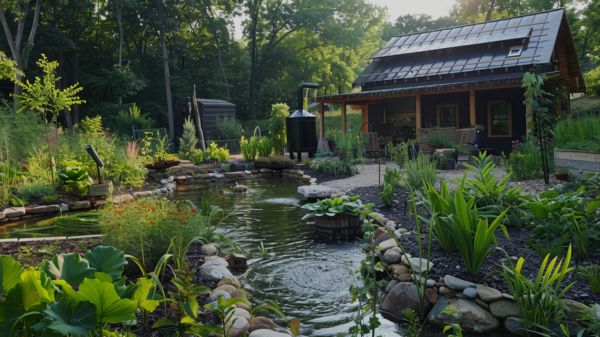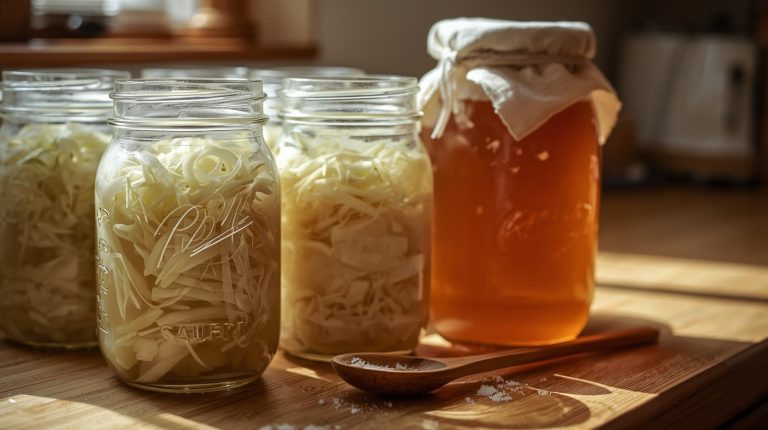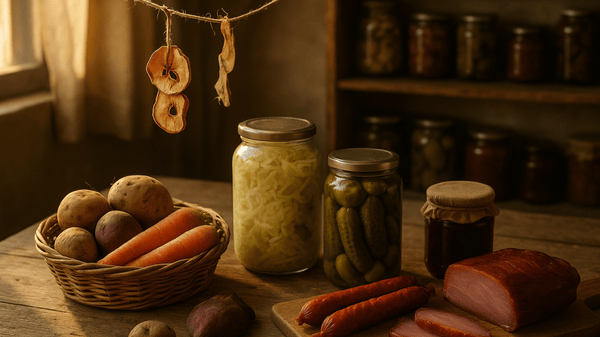You can achieve water independence by integrating effective rainwater harvesting techniques, employing greywater systems, and maximizing groundwater replenishment strategies.
Capturing rainwater not only reduces your dependency on municipal sources but also mitigates flooding risks, while greywater reuse for irrigation cuts down on fresh water consumption. Additionally, enhancing groundwater replenishment through sustainable irrigation and infiltration methods sustains aquifer levels.
Prioritizing these strategies, coupled with a rigorous assessment of your daily water usage and the implementation of water-saving technologies, assures a more resilient and efficient water management system. Exploring further reveals actionable insights and methodologies to fine-tune your approach for maximum sustainability.
Discover Independence with Our Innovative Water Solution
Key Takeaways
- Implement rainwater harvesting and greywater systems to reduce reliance on municipal water sources.
- Use smart meters and precision hydration strategies to monitor and optimize water usage.
- Install water-saving technologies like drip irrigation to minimize waste in gardening and agriculture.
- Regularly maintain water collection and filtration systems to ensure quality and efficiency.
- Engage in community-driven projects and education to promote sustainable water management practices.
Understanding Water Independence
In today’s world, grasping the concept of water independence is crucial for sustainable living. You’re not just saving the planet; you’re fundamentally becoming the superhero of your own utility bill—cape optional. Water independence means you’re reducing reliance on municipal systems through innovative water conservation strategies, such as rainwater harvesting. These aren’t just fancy buzzwords; they’re your ticket to a sustainable, slightly smugger existence.
Let’s explore the nitty-gritty. Sustainable practices in water management often include rainwater harvesting and greywater recycling. Imagine capturing rain from your roof—not with a giant butterfly net, but with a sophisticated system that stores water for later use. You’re like a water wizard, conjuring H2O from thin air (well, almost).
Greywater systems, on the other hand, let you reuse water from your showers and sinks to irrigate your garden. It’s like giving your plants a second-hand drink, but they aren’t picky.
Implementing these systems isn’t just throwing a bucket under a leaky gutter. It involves careful planning, a bit of DIY enthusiasm, and a willingness to embrace the quirks of living sustainably. By choosing the right rainwater collection system, you can make a significant impact on your water consumption.
Assessing Your Water Needs
To accurately gauge your water needs, you’ll first need to estimate your daily consumption. Analyze household usage patterns to identify peak demands and inefficiencies in water use. Additionally, conduct a thorough analysis of essential activities to determine which require the most water and prioritize their efficiency improvements.
Daily Consumption Estimation
Estimating your daily water needs is a critical first step in achieving water independence. Now, let’s delve into the nitty-gritty of your water footprint without drowning in complexity.
You’re not just a simple H2O consuming machine; you’re a sophisticated hydration strategist! Calculating your individual water needs involves considering several factors like body weight, activity level, and even your local climate—yes, sweating in the sun isn’t just for show, it actually ups your water ante.
To kick things off, the average person needs about 2.7 to 3.7 liters of water per day. But who’s average, right? If you’re running marathons or a Netflix marathon might tweak those numbers.
Your water footprint expands beyond drinking. It includes the water used in food production and other personal consumption. Don’t splash around in ignorance!
Adopting precision hydration strategies can help streamline your consumption. Think of it like fine-tuning a complex machine where every drop counts.
Small adjustments, such as monitoring your intake with a smart water bottle or installing a low-flow showerhead, can greatly impact your overall water footprint. Master these elements, and you’ll not only quench your thirst but also pave the way for a sustainable water-independent lifestyle.
Household Usage Patterns
Understanding your household’s water usage patterns marks an essential phase in evaluating your overall water needs.
Let’s dive deep—pun intended—into the sea of your daily water use. You’ll first need to track how much water each activity consumes. Sounds like a spy mission, right? But instead of chasing villains, you’re after drips and flows!
Start with your water bill—this document is like the diary of your water footprint, revealing the secrets of your consumption habits. By analyzing monthly variations, you can identify if your water use spikes during summer pool parties or if it’s consistently high due to a love affair with long showers.
Next, consider the invisible water use—yes, it’s a thing. This includes water embedded in the products you buy. Your blue jeans, for instance, are a veritable swimming pool regarding the water used during their production.
Knowledge of these hidden water uses sharpens your conservation habits, making you a water-saving ninja.
Essential Activities Analysis
Nearly every drop of water you use at home plays an essential role in fulfilling your essential daily activities. From quenching your thirst to flushing mysteries down the toilet, each activity demands a specific amount of H2O.
Let’s explore a detailed analysis of your water use, shall we?
First, consider the quality of water you’re using. It’s not just about avoiding the monster from the black lagoon in your tap; it’s about ensuring each drop is up to the task—be it cooking, cleaning, or covert midnight gardening. High-quality water isn’t just a luxury; it’s a necessity for efficient home management.
Next, map out your daily water use. You’d be surprised how much goes into seemingly simple tasks. For example, brushing your teeth can consume 1-2 gallons, depending on your zeal for dental hygiene.
Showering can use anywhere from 17 to infinity gallons, especially if you’re the type who performs entire rock operas in there.
Now, apply conservation strategies. Installing water-saving fixtures isn’t just about saving the planet; it’s about saving your wallet from aquatic bankruptcy.
Think aerators, low-flow showerheads, and the holy grail of conservation: the dual-flush toilet. By optimizing these elements, you’ll not only preserve precious resources but also maintain a humorously high standard of living.
Rainwater Harvesting Basics
As you explore rainwater harvesting, understanding the various collection techniques is vital; these range from simple rain barrels to more complex systems involving catchment surfaces and storage tanks.
Recognizing the benefits of harvesting rainwater, such as reducing dependence on municipal systems and mitigating flood risk, can motivate you to implement these practices effectively.
In addition, harvested rainwater can serve different purposes, from irrigation to vehicle washing, further enhancing its utility.
Furthermore, these practices can contribute to significant cost savings and financial benefits, making them a worthwhile investment.
Additionally, regular maintenance of your system, including inspecting for leaks and ensuring cleanliness of catchment areas, is essential to maximize efficiency and water quality.
Rainwater Collection Techniques
Collecting rainwater, an ancient practice now refined by modern techniques, enables you to reduce dependence on municipal systems and control your own water supply.
Let’s explore the nitty-gritty of rainwater collection techniques, shall we? You’ll find that grasping the basics of rainwater filtration and the use of collection barrels can be as exhilarating as finding socks that match after laundry day.
First off, rainwater filtration isn’t just a fancy phrase to impress your eco-conscious friends. It’s a vital step to guarantee the water you collect is free from contaminants and as moody as a cat on a rainy day.
Typically, this involves using pre-filtration to remove debris and sediments. Think of it as a bouncer at a club, only letting in the clean, good vibes.
Next, collection barrels come into play. These aren’t just any barrels; they’re your water-saving warriors. Positioned under downspouts, they capture rainwater at its freshest, like catching lightning in a bottle, only less dangerous and more practical.
Make sure to choose barrels that are dark and made of UV-protected materials to prevent algae growth—because nobody invites algae to a pool party.
Benefits of Harvesting Rainwater
Harvesting rainwater offers you substantial benefits, both environmentally and economically.
Let’s explore the nitty-gritty, shall we? To begin with, rainwater quality is excellent, unlike the latest blockbuster sequel. It’s relatively pure, barring a few airborne particles—think of it as nature’s own distilled drink, minus the fancy branding.
Collecting this pristine resource reduces reliance on treated municipal water, which often involves a cocktail of chemicals and energy consumption to make it potable. You’re not just saving money; you’re auditioning for the role of Eco-Hero of the Year.
Now, let’s talk turkey—environmentally speaking. The environmental impact of rainwater harvesting is akin to giving Mother Nature a spa day.
System Maintenance Tips
To guarantee your rainwater harvesting system operates efficiently, regular maintenance is vital. You’ve got yourself a nifty setup, but if you neglect the nitty-gritty of upkeep, it’s like owning a sports car and never changing the oil – eventually, something’s going to sputter.
First off, let’s explore the heart of your system: the filtration systems. These are the unsung heroes, tirelessly screening out debris and contaminants so you don’t end up watering your tomatoes with something resembling swamp water. It’s essential to clean or replace the filters as per the manufacturer’s guidelines. Typically, this might be every few months, but keep an eye on them; a clogged filter is as effective as a chocolate teapot.
Next, establish a maintenance schedule that doesn’t play hide and seek with your calendar. Regular inspections every three to six months are a good rule of thumb. Check for sediment buildup in the storage tanks, make sure all gutters are leaf-free, and confirm that downspouts are directing water like a maestro leading an orchestra.
Greywater Systems Explained
Understanding greywater systems is essential for anyone aiming to enhance their water independence. Similar to rainwater harvesting systems, the implementation of greywater systems isn’t just for folks who wear socks with sandals—it’s a scientifically savvy step towards sustainable living.
Greywater, which you generate every time you shower, wash dishes, or do laundry, usually goes straight to sewage. But, why waste waste when you can reuse it?
Here’s the scoop: greywater systems divert this mildly used water away from the sewer and into your garden. These systems, much like their rainwater counterparts, require an initial investment but can lead to significant long-term savings and environmental benefits.
Think of it as giving your plants a drink, not with Evian, but with something a tad less posh. These systems filter out the big nasties (like that glob of hair you lost last Tuesday) and then repurpose the water for irrigation systems. It’s like rigging your house to work like a mini eco-cycle.
Now, don’t confuse greywater with blackwater—your toilet’s contributions aren’t invited to this party. By recycling greywater, you’re reducing your freshwater footprint and giving your plants a nutrient-rich cocktail.
It’s a win-win, really. And remember, while setting up, you’re not just installing some pipes—you’re orchestrating a backyard symphony of sustainability.
Groundwater Replenishment Techniques
Building on the theme of sustainable water management, another effective strategy for boosting your water independence involves groundwater replenishment techniques. Now, don’t confuse this with a new spa treatment for the Earth, although the planet probably wouldn’t mind a little pampering.
Instead, focus on aquifer recharge and sustainable irrigation—two heavyweight champions in the underground world of water replenishment.
Aquifer recharge isn’t just a fancy term thrown around at hydrologist parties. It’s a critical process where you, yes you, can help direct excess surface water down to the thirsty underground aquifers. This can be done through methods like infiltration basins or permeable pavements that act like a sponge, soaking up water and escorting it downwards.
It’s like setting up a blind date between rainwater and aquifers!
Meanwhile, sustainable irrigation takes the stage to guarantee that the water you use for your crops can also contribute to groundwater replenishment. This isn’t about flooding fields willy-nilly but using precise irrigation techniques that minimize wastage and maximize efficiency.
Think of it as teaching your water to do a double-duty dance, nourishing your crops while also sneaking back into the groundwater supplies. Now, isn’t that a neat trick for water independence?
Water Storage and Preservation
Often overlooked, water storage and preservation are essential components in achieving water independence. You might think it’s just about hoarding H2O like a squirrel with nuts, but it’s far more sophisticated.
Let’s explore the nitty-gritty of water filtration and conservation methods, shall we?
First up, water filtration. This isn’t your average coffee filter situation. We’re talking high-tech, pores-so-small-they-could-be-on-a-reality-show-about-tiny-houses kind of filters. These systems are vital because they keep out the nasties (think bacteria, viruses, and your ex’s bad vibes) while ensuring that the only thing flowing more freely than water is clean, safe water.
Moving on to conservation methods, you’ve got options ranging from simple to “Is this sci-fi?” Simple might be fixing leaks — because each drop counts, and your water bill shouldn’t resemble a phone number.
On the more advanced front, implementing rainwater harvesting systems can turn every downpour into a liquid asset, literally. It’s like catching free money from the sky, except it’s water and it’s actually useful.
In essence, mastering these techniques means not just surviving but thriving independently from the grid. So, gear up and let’s keep that water flowing smarter, not harder.
Implementing Water-Saving Technologies
Immerse yourself in the world of water-saving technologies to considerably cut down on your daily water usage and enhance efficiency in your home or business.
Let’s plunge into the nitty-gritty of two groundbreaking innovations: drip irrigation and smart meters.
You might think of drip irrigation as the ninja of garden watering systems. It stealthily delivers water directly to the roots of plants, minimizing evaporation and runoff.
It’s not just dripping water willy-nilly; it’s a meticulously designed system that guarantees every drop counts. This method can save up to 60% more water than traditional watering methods. Talk about being a water-saving warrior!
Moving on to smart meters—these aren’t your average meters. They’re like the brainiacs of water management.
Smart meters track water usage in real-time, sending data directly to your smartphone or computer. You’re not just guessing your water use; you’re scientifically managing it.
This can help detect leaks that are as sneaky as a cat in socks, potentially saving gallons of water—and your wallet.
Community-Driven Water Projects
In response to escalating water scarcity, community-driven water projects have emerged as essential solutions that empower local populations to sustainably manage and preserve their water resources.
These projects aren’t just about splashing around some new ideas; they’re an in-depth exploration into the pool of sustainability and active community engagement.
You see, the genius of these initiatives isn’t just their grassroots charm but their knack for tapping into local knowledge and resources.
This isn’t your typical top-down rainfall of directives. Nope, it’s more like irrigating the desert with a thousand tiny rain dances, each perfectly adapted to its little patch of parched earth.
The community members aren’t just passive sippers; they’re the main splash-makers, fully engaged in every drip and drop of the project’s development.
What’s more, the focus on sustainability isn’t just some trendy green sticker slapped onto the project.
It’s about creating systems that, like a well-aged wine, get better over time.
These projects aim to be so sustainable that even your grandchildren will be toasting to their success with glasses filled with clean, abundant water.
Frequently Asked Questions
Can Water Independence Impact Local Wildlife and Ecosystems?
Absolutely, your efforts towards water independence can ripple through local ecosystems.
By managing water sustainably, you’re fundamentally donning a superhero cape for habitat conservation. Efficient use prevents habitat disruption, allowing species to adapt without relocating their family treehouses!
Remember, every drop you save does more than just lower your utility bill—it whispers a sweet “thank you” in Mother Nature’s ear, ensuring her critters stay put and thrive.
Are There Tax Benefits for Adopting Water Independence Practices?
You’re eyeing those tax deductions, aren’t you?
Well, adopting water independence practices can indeed lighten your tax burden. By investing in water conservation systems, you might qualify for various incentives aimed at promoting sustainable living.
These incentives often come as tax credits or deductions, rewarding you for your eco-friendly choices. Analyzing the fine print of these benefits reveals a direct encouragement from governments to reduce water usage and protect our natural resources.
How Does Climate Change Affect Water Independence Strategies?
Climate change ramps up your need for drought resilience and smarter resource allocation. As temperatures climb and precipitation patterns shift, you’ll find water sources drying up faster than a misplaced iPhone in rice.
To maintain water independence, you’ll need to tweak strategies, perhaps by upgrading to more efficient systems or harvesting rainwater—even if it’s just for bragging rights at the next neighborhood BBQ.
Adapt, or you might end up thirstier than a fish in a desert!
What Are Legal Considerations for Collecting and Using Rainwater?
Maneuvering the maze of rainwater regulations isn’t just a drop in the bucket—it’s vital for staying on the right side of the law! You’ll find that some areas require harvesting permits, reflecting diverse local water rights and environmental policies.
It’s essential to dive deep into your specific jurisdiction’s statutes to guarantee compliance. Failure to do so isn’t just a legal faux pas; it can lead to hefty fines or other serious repercussions.
Is Water Independence Feasible in Urban Environments?
You might think you’re stuck with city water, but urban agriculture and greywater recycling can pave the way to water independence.
In densely populated areas, you’ve got to be smart about it. Utilizing rooftop gardens or vertical farming maximizes limited space, and repurposing greywater keeps your plants hydrated without tapping into the mains.
While it sounds a bit sci-fi, these methods are practical and increasingly necessary.
Conclusion
You’re on the brink of achieving water independence, but remember, the journey doesn’t end here. Integrating advanced greywater systems, optimizing rainwater harvesting, and exploring groundwater replenishment are just the beginning.
Each technique, meticulously applied, not only conserves but revitalizes your water supply. As you refine these methods, continually assess their effectiveness. By doing so, you’ll not just meet your needs—you’ll redefine them, ensuring sustainability that resonates through your community and beyond.
Embrace this challenge; the impact is profound.




